When it comes to reusable grocery bags, there are so many options out there that it may seem a bit overwhelming. You have to consider which one is right for you: Do you need something small and compact so you can carry it with you everywhere? Or, do you need something large and durable for your big weekly grocery trips?
But you may also be thinking, “What is this bag actually made of?” Different reusable bags are made from different materials, and because of that, some are more environmentally friendly than others. So you may also be considering, “Is a cotton bag more sustainable than a polyester bag?” Or, “Is the hard plastic bag I want to purchase really that much better than a plastic grocery bag?”
Reusable bags, regardless of material, are going to create less of an environmental impact than the mass amounts of single use plastic bags that enter the environment everyday. But the difference in impact is actually quite surprising.
Regardless of type though, it’s always important to keep in mind that these bags are not meant to be single-use. The more times you use them, the more environmentally friendly they become.
We’ve compiled a list below of various fabrics and materials that are most commonly used to produce reusable bags. You’ll be able to determine which bags are made from what materials and the environmental impact of each type.
Natural Fibers
Jute Bags
A great, natural option when it comes to reusable bags is a jute bag. Jute is one of the few alternatives to plastic that is completely biodegradable and has a relatively low environmental impact. Jute is an organic material that is mainly grown and cultivated in India and Bangladesh.
The plant requires little water to grow, can grow in and actually rehabilitate wasteland, and reduces large amounts of CO2 due to it’s carbon dioxide assimilation rate. It is also extremely durable and relatively cheap to buy. The only downside is that it’s not very water resistant in its natural form.
Cotton Bags
Another option is a traditional cotton bag. Cotton bags are a common reusable alternative to plastic bags. They are lightweight, packable, and can be come in handy for a variety of uses. They also have the potential to be 100% organic, and they’re biodegradable.
However, because cotton requires so many resources to grow and cultivate, they must be used at least 131 times in order to outweigh their environmental impact.
Synthetic Fibers
Polypropylene (PP) Bags
Polypropylene bags, or PP bags, are the bags you see at grocery stores near the check out isle. They’re durable reusable plastic bags that are designed for multiple uses. They can be made from both non-woven and woven polypropylene and come in a variety of colors and sizes.
While these bags are not compostable or biodegradable, they are the most environmentally efficient bags compared to traditional HDPE grocery bags. With just 14 uses, PP bags become more eco-friendly than single-use plastic bags. They also have the potential to be made from recycled materials.
Recycled PET Bags
Recycled PET bags, as opposed to PP bags, are exclusively made from polyethylene terephthalate (PET) or recycled water bottles and containers. These bags, while still made from plastic, utilize the unnecessary waste from plastic water bottles and produce a wholly recycled and useful product.
PET bags pack down into their own tiny stuff sack and can be used for years. They’re strong, durable, and from a resource point of view, have the lowest environmental footprint because they make use of otherwise disposable waste.
Polyester
Many fashionable and colorful bags are made from polyester. Unfortunately, unlike recycled PET bags, virgin polyester requires nearly 70 million barrels of crude oil each year to produce.
But on the plus side, each bag only creates 89 grams of greenhouse gas emissions, which is the equivalent to seven single use HDPE bags. Polyester bags are also wrinkle resistant, water resistant, and can be easily folded down to bring with you everywhere.
Nylon
Nylon bags are another easily packable reusable bag option. However, nylon is made from petrochemicals and thermoplastic—it actually requires more twice as much energy to produce than cotton and more crude oil to produce than polyester.
There are many options to choose from, but that doesn’t mean that choosing a reusable bag has to be confusing. As stated before, the more times you use a bag, the more environmentally friendly it becomes; so it’s important to find a bag that suits your personal needs.
Post time: Jul-28-2021

